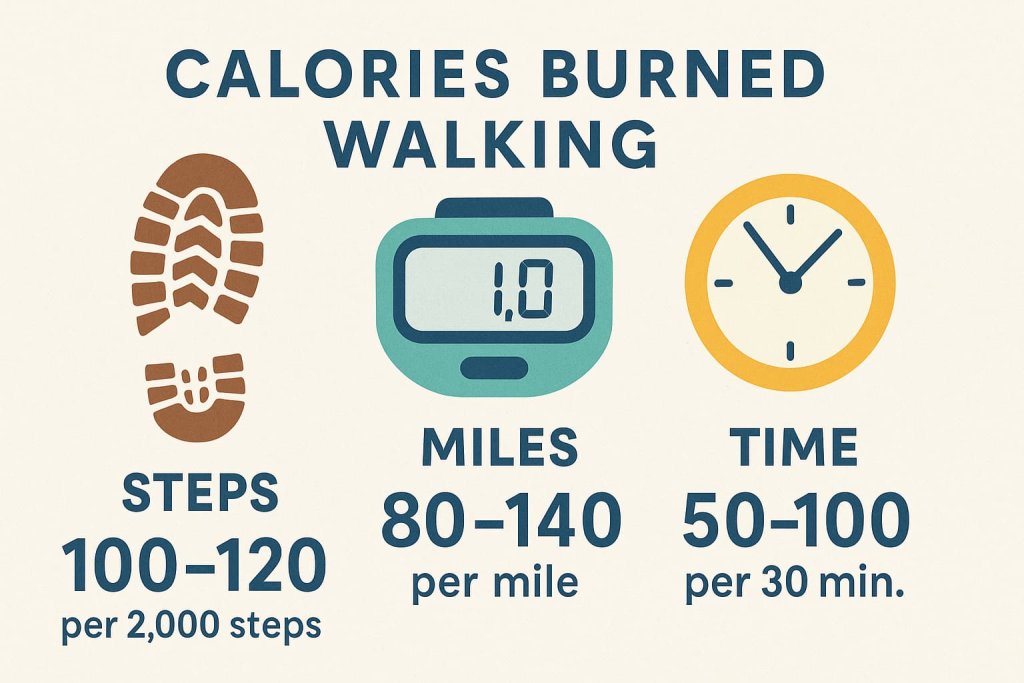Walking burns about 100 calories per mile for a 150 lb adult, but the real answer depends on your weight, walking speed, and terrain. Whether you walk for fitness, weight loss, or everyday activity, knowing your calorie burn can help you set realistic goals and stay motivated.

Walking is one of the safest, most accessible ways to burn calories, improve your health, and reach your weight loss targets—without needing a gym or expensive gear. In this comprehensive guide, you’ll find research-backed estimates, practical strategies to boost your calorie burn, detailed charts, FAQs, and expert-backed tips for every fitness level.
How Many Calories Does Walking Burn? (Estimates & Why It Matters)
The average person burns between 80 and 140 calories per mile of walking, based mostly on weight and speed. Here’s a breakdown:
| Weight (lb) | Pace (mph) | Calories Burned per Mile |
|---|---|---|
| 120 | 2.5–3 | 80–85 |
| 150 | 2.5–3 | 95–105 |
| 180 | 2.5–3 | 115–125 |
| 200 | 2.5–3 | 130–140 |
- A 150 lb person walking at a moderate pace (2.5–3 mph) will burn about 100 calories per mile.
- Lighter individuals burn less; heavier people burn more per mile.
- Walking faster, uphill, or carrying weight boosts calorie burn.
Why this matters:
- Plan your daily step goals for weight loss or maintenance.
- Accurately estimate your calorie deficit (if you’re tracking calories).
- Find ways to get more from every walk!
Pro Tip: Use the “half your weight” rule: for every mile walked, burn about half your body weight in calories (e.g., 180 lb person burns ~90 calories/mile at a leisurely pace; more if brisk).
Sources: Verywell Fit, 2025, Prevention, 2025
The Science: What Determines Calories Burned Walking?

1. Body Weight
Heavier people burn more calories with every step because moving a larger mass requires more energy. For example:
- A 200 lb person walking a mile burns 30–40% more than someone weighing 120 lb.
- This difference adds up—especially over weeks or months.
2. Walking Pace & Speed
The faster you walk, the more calories you burn per minute (though not always per mile).
- Slow walk (2 mph): Lower burn, suitable for beginners or older adults.
- Moderate walk (2.5–3 mph): ~100 calories/mile for 150 lb person—this is an easy “conversation pace.”
- Brisk walk (3.5–4+ mph): Up to 50% more calories burned per minute. This pace gets your heart rate up and is great for fitness and weight loss.
Research tip: Brisk walking for at least 30 minutes most days is recommended by CDC guidelines.
3. Distance & Duration
- The longer or farther you walk, the more calories you’ll burn—simple math!
- 3 miles ≈ 300 calories (for 150 lb person)
- 10,000 steps (~5 miles) ≈ 500 calories
4. Terrain, Incline, and Surface
- Uphill/hilly walks can boost calorie burn by up to 60% compared to flat ground.
- Uneven trails (like sand or gravel) also require more effort.
- Downhill burns slightly fewer calories than flat or uphill.
5. Other Factors
- Added weight: Carrying a backpack or using walking poles increases intensity.
- Age, sex, fitness level, and metabolism all slightly affect calorie burn, but the biggest impact comes from weight, pace, and distance.
Calories Burned: Step, Mile, and Time Calculations
How Many Calories Do You Burn Per Step?
- Most adults burn about 0.04–0.06 calories per step (varies by weight).
- So, every 2,000 steps ≈ 80–120 calories.
Calories Burned by 10,000 Steps
- 10,000 steps ≈ 4–5 miles (depends on stride).
- Typical calorie burn by weight:
- 120 lb: 400–420 calories
- 150 lb: 500–520 calories
- 180 lb: 600–620 calories
Example: If your daily step goal is 8,000 and you weigh 160 lb, you’ll burn about 400 calories just from walking!
Calories Burned Per 30 Minutes & 1 Hour
- 30 minutes, moderate pace (150 lb): 120–140 calories
- 1 hour, moderate pace: 240–280 calories
- For a faster pace (4 mph): Burn up to 175–210 calories in 30 minutes.
How to Burn More Calories While Walking
Want to get more out of your walk? Try these research-backed tips:
1. Increase Your Pace
- Move from a stroll to a brisk pace.
- Short “power-walk” intervals—30–60 seconds of faster walking every few minutes—can trigger greater calorie burn (and fitness improvements).
- Use a fitness tracker or phone app to monitor your speed.
2. Add Inclines, Hills, or Stairs
- Find a hilly route, or use a treadmill incline.
- Walking uphill increases muscle engagement and calorie expenditure.
- Even short bursts of stairs can make a big difference!
3. Add Weight or Resistance
- Use a light backpack or weighted vest (if you’re fit and have no joint problems).
- Walking poles can increase upper body involvement and calorie use.
4. Go Farther or Longer
- Extend your walk by just 5–10 minutes each week.
- Try “walk-and-talk” meetings, or walk during phone calls for easy extra steps.
5. Vary Terrain
- Switch up your routine: pavement, trail, sand, or grass all offer unique challenges.
Pro Tip: Try combining strategies—brisk intervals + hills + a slightly longer route—for even more calorie burn and fitness benefits.
Real-World Examples: Walking for Every Goal
- Example 1: Jenny weighs 120 lb and walks 2 miles at 3 mph on flat ground each morning. She burns about 170 calories per walk and hits her 10,000 steps with one extra afternoon stroll.
- Example 2: David weighs 200 lb, does a 30-minute brisk walk on hilly terrain (4 mph, 1.5 miles). He burns close to 230 calories, nearly double what he’d burn strolling the same distance on flat ground.
- Example 3: Kim is trying to lose weight. She weighs 180 lb and averages 8,500 steps per day (about 4.25 miles), burning around 525 calories daily through walking alone. Combined with healthy eating, she loses about 1 pound every 7–10 days.
Key takeaway: Your weight, pace, and route matter most—adjust these to match your goals!
Practical Tips for Tracking & Increasing Your Walking Calorie Burn
- Use a fitness tracker or app to log steps, distance, and estimated calorie burn.
- Set daily or weekly walking goals based on calories (e.g., burn 1,500 calories/week walking).
- Incorporate walking into daily routines: Park further away, walk during lunch breaks, or take stairs.
- Join walking groups or challenges for motivation and accountability.
- Listen to music, podcasts, or audiobooks to make walks enjoyable and help you go farther without noticing.
Frequently Asked Questions (FAQ)
Does walking burn belly fat?
Walking helps reduce overall body fat, including belly fat, but you can’t target fat loss in one area (“spot reduction” is a myth). Combine regular walking with a healthy diet for best results.
How many calories does walking 30 minutes burn?
For most adults, 30 minutes at a moderate pace burns 100–150 calories. Heavier or faster walkers will burn more.
What’s the best way to track calories burned while walking?
- Use smartwatches (Apple, Fitbit, Garmin) or free phone apps (MapMyWalk, Google Fit).
- Online calculators like the Fitness Activity Calculator can give tailored estimates.
Is walking enough for weight loss?
Walking can absolutely support weight loss, especially when paired with mindful eating. A 30-minute brisk walk every day (plus daily activity) can help you burn an extra 1,000+ calories per week.
Can you burn more calories by walking faster or with weights?
Yes—brisk walking and adding resistance (hills, weights) both increase calorie burn per minute and mile.
How many calories does walking 10,000 steps a day burn?
Most people burn 400–600 calories walking 10,000 steps, depending on weight and pace.
Latest Research & Updates (2025)
- The “100-calorie-per-mile” rule is still a solid guideline for most adults (Verywell Fit, 2025).
- Brisk walking and interval walking are proven to boost calorie burn and overall health (CDC Physical Activity Guidelines).
- Incline walking, intervals, and walking with light resistance (like a backpack or poles) are all effective, supported by new fitness research (Prevention, 2025).
- A recent review (The Times, April 2025): 15 minutes of brisk walking daily reduces risk of early death by 20%, highlighting walking’s health benefits beyond calories.
Action Plan: How to Maximize Calorie Burn from Walking
- Set a daily step or distance goal: Start with your current average and add 500–1,000 steps per week.
- Aim for brisk pace (3–4 mph): Try intervals—alternate 2 minutes fast, 2 minutes moderate.
- Mix up routes: Include hills, stairs, and off-road paths when possible.
- Add resistance: Use a backpack (5–10 lb) or walking poles if safe for you.
- Track your progress: Use a fitness app or wearable for real-time feedback.
- Stay consistent: Make walking a daily habit—every step counts!
Conclusion & Next Steps
Most people burn between 80 and 140 calories per mile of walking—depending on weight, speed, and route. Walking is simple, low-impact, and effective for burning calories, improving heart health, and boosting mental well-being.
To get started, set a walking goal, pick up the pace, add variety, and use a tracker to monitor your progress. Walking consistently is one of the easiest ways to support your fitness, weight loss, and long-term health.
Ready to see results? Start walking today—every step moves you closer to your goals!
Check your personalized calorie burn using the Fitness Calorie Calculator, or consult your healthcare provider for tailored advice.
